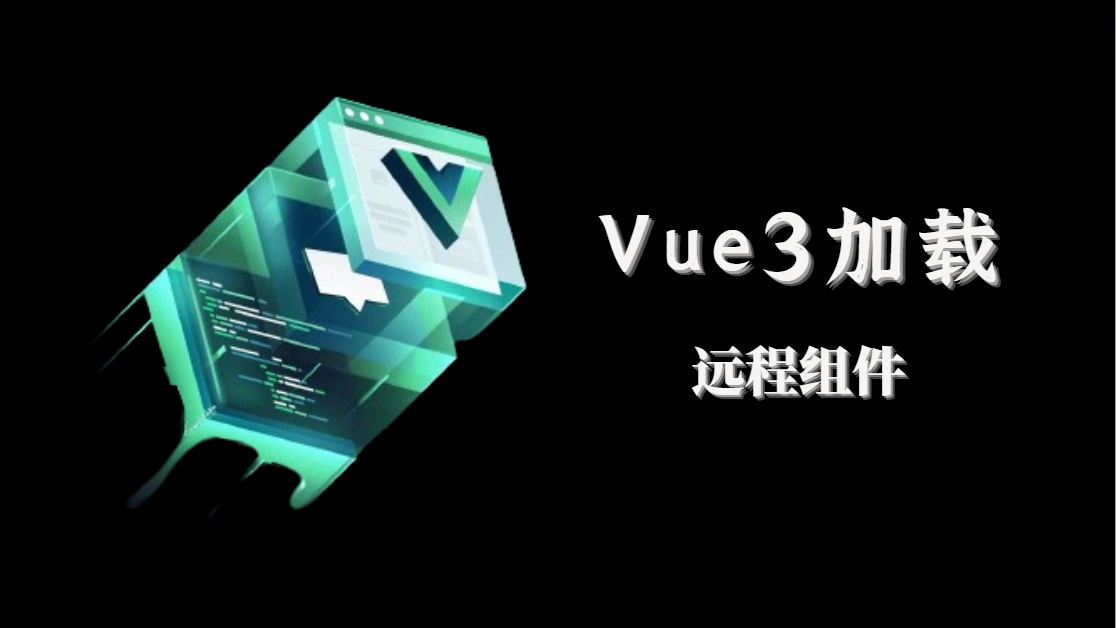vue
vue3+vite自动化注册全局组件
vue3加载远程组件
Vue Vine 编写 Vue 的另一种风格
Vueuse 实现数字滚动 Count-to
学会这几个常用功能,给你的 vue3 项目加点餐!
为什么有些 Vue3 项目已经开始弃用 Pinia 了?
Vue3 的 5 个组合式 API 方法
Vue3+TS+canvas 项目预览图片时,添加水印,浏览器禁止右键功能、前端禁止直接获取图片地址
Vue3.x 生态最能打的组合!
vue2封装常用工具类
使用 v-once 和 v-memo 进行 Vue 渲染优化
基于 Vue + Element plus + Node 实现大文件分片上传,断点续传和秒传的功能!
Vue中的$attrs和$listeners对象有什么作用?
本文档使用 MrDoc 发布
-
+
首页
vue3加载远程组件
**你有没有遇到过这样的场景:项目需要频繁更新组件,或者需要动态加载某些第三方组件,但又不想每次都重新打包发布?🤔** 在现代Web开发中,随着项目需求的多样化,**动态加载远程组件成为一种越来越受欢迎的解决方案。**  ## 什么是远程组件? **远程组件,顾名思义,就是从远程服务器动态加载的组件。** 这种技术可以帮助我们在不重新构建和部署整个应用的情况下,动态更新和扩展前端功能。 这在微前端架构和大型项目中尤为有用。 例如,我们可以通过远程组件实现独立模块的更新,提升开发效率和用户体验。 ## 为什么使用Vue3加载远程组件? Vue3提供了更强大的功能和更好的性能,使得动态加载远程组件变得更加容易和高效。 以下是几个主要的优势: 1. **Composition API**:Vue3的Composition API使得代码更加模块化和易于维护,适合动态加载组件的实现。 2. **Script Setup**:Vue3的`<script setup>`语法简化了组件的定义和使用,更加直观和简洁。 3. **性能提升**:Vue3在性能上有了显著提升,特别是对于大型应用和动态加载的场景。 ## ue3加载远程组件的基本原理 在Vue3中加载远程组件的基本原理是通过JavaScript的动态导入(`import()`)功能,将远程的组件代码加载到本地,然后注册为Vue组件。 具体步骤如下: 1. 使用`fetch`或其他HTTP库获取远程组件的代码。 2. 使用`new Function`将代码转换为可执行的模块。 3. 动态导入并注册组件。 ## 实战:Vue3加载远程组件 接下来,我将通过一个具体的实例,详细讲解如何在Vue3中加载远程组件。 我们将创建一个简单的Vue应用,并从远程服务器动态加载一个组件。 ### 环境搭建 首先,我们需要搭建一个Vue3的开发环境。 如果你还没有安装Vue CLI,可以通过以下命令进行安装: ```bash npm install -g @vue/cli ``` 然后,创建一个新的Vue3项目: ```bash vue create remote-component-demo ``` 选择`Vue 3`,并按照提示完成项目创建。进入项目目录: ```bash cd remote-component-demo ``` 安装所需的依赖: ```bash npm install ``` ### 项目结构 为了便于演示,我们假设远程组件的代码保存在一个远程服务器上,可以通过URL访问。 项目结构如下: ```bash remote-component-demo/ |--public/ |-- src/ ||-- components/ |||--RemoteComponent.vue ||--App.vue ||-- main.js |--package.json |-- vue.config.js ``` ### 创建本地组件 在`src/components/`目录下创建一个本地组件`RemoteComponent.vue`,用于测试远程加载功能: ```vue <template> <div> <h3>This is a remote component</h3> <p>{{ message }}</p> </div> </template> <script setup> import { ref } from 'vue'; const message = ref('Hello from the remote component!'); </script> <style scoped> h3 { color: #42b983; } </style> ``` ### 配置远程服务器 在实际应用中,远程组件的代码通常保存在一个远程服务器上。 为了演示,我们可以使用一个本地服务器来模拟远程服务器。 你可以使用任何HTTP服务器,比如`http-server`: ```bash npm install -g http-server ``` 然后,在`public/`目录下创建一个名为`remote-component.js`的文件,并将上面的组件代码保存为JavaScript字符串: ```js export default{ template:` <div> <h3>This is a remote component</h3> <p>{{ message }}</p> </div> `, setup(){ return{ message:'Hello from the remote component!' } } } ``` 启动本地服务器: ```bash http-server ./public ``` 假设服务器运行在`http://localhost:8080`,现在你可以通过`http://localhost:8080/remote-component.js`访问远程组件的代码。 ### 动态加载远程组件 在`src/App.vue`中,添加动态加载远程组件的逻辑: ```vue <template> <div id="app"> <h1>Vue3 Remote Component Demo</h1> <button @click="loadComponent">Load Remote Component</button> <component :is="remoteComponent"></component> </div> </template> <script setup> import { ref }from'vue'; const remoteComponent =ref(null); asyncfunctionloadComponent(){ try{ const response =awaitfetch('http://localhost:8080/remote-component.js'); const code =await response.text(); constmodule=newFunction(`return ${code}`)(); remoteComponent.value=module.default; }catch(error){ console.error('Failed to load remote component:', error); } } </script> <style scoped> #app { font-family:Avenir,Helvetica,Arial, sans-serif; text-align: center; color:#2c3e50; margin-top:60px; } button{ padding:10px20px; margin:20px; font-size:16px; cursor: pointer; } </style> ``` 在这个例子中,我们使用`fetch`获取远程组件的代码,并使用`new Function`将其转换为可执行的模块。 然后,将模块的默认导出赋值给`remoteComponent`,通过Vue的动态组件`<component :is="remoteComponent"></component>`进行渲染。 ### 运行项目 现在,我们已经完成了所有的配置。 运行项目: ```bash npm run serve ``` 打开浏览器,访问`http://localhost:8080`,点击“Load Remote Component”按钮,你将看到动态加载的远程组件。 ## 高级技巧 ### 缓存远程组件 为了提高性能,你可以将远程组件缓存到本地。 你可以使用浏览器的`localStorage`或`sessionStorage`来实现缓存。 ```js async functionloadComponent(){ const cachedComponent =localStorage.getItem('remoteComponent'); if(cachedComponent){ remoteComponent.value=newFunction(`return ${cachedComponent}`)().default; return; } try{ const response =awaitfetch('http://localhost:8080/remote-component.js'); const code =await response.text(); localStorage.setItem('remoteComponent', code); constmodule=newFunction(`return ${code}`)(); remoteComponent.value=module.default; }catch(error){ console.error('Failed to load remote component:', error); } } ``` ### 异步组件 Vue3提供了异步组件的支持,你可以将远程组件封装为异步组件: ```js const remoteComponent =defineAsyncComponent(async()=>{ const response =awaitfetch('http://localhost:8080/remote-component.js'); const code =await response.text(); constmodule=newFunction(`return ${code}`)(); returnmodule.default; }); ``` ### 安全性考虑 在实际应用中,动态加载远程组件可能存在安全风险。 例如,远程代码可能被篡改,导致安全漏洞。为了提高安全性,你可以使用内容安全策略(CSP)和代码签名等技术来保护你的应用。 ## 总结 在实际项目中,我深刻体会到动态加载远程组件的强大和便利。 无论是模块化开发、微前端架构,还是动态更新功能,远程组件都能帮助我们更高效地完成工作。 > 原文地址 https://mp.weixin.qq.com/s/gllIrgcJodpsUtk985i65g
admin
2024年7月9日 15:20
转发文档
收藏文档
上一篇
下一篇
手机扫码
复制链接
手机扫一扫转发分享
复制链接
Markdown文件
分享
链接
类型
密码
更新密码